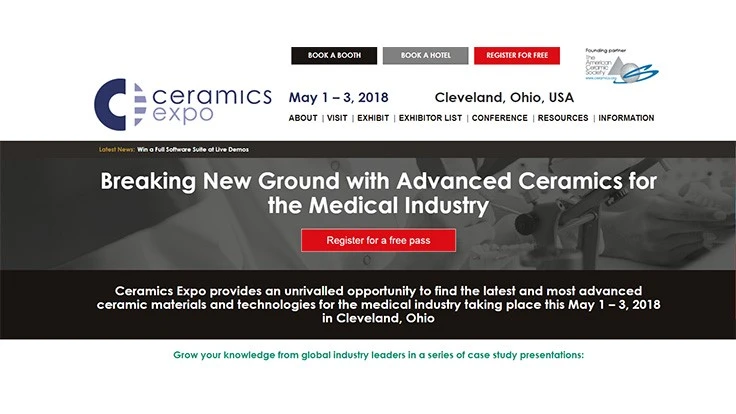
Cleveland, Ohio – Ceramics Expo 2018 will highlight what the latest materials contribute, how novel technologies play a crucial role in design and manufacturing, and what innovators are bringing to the market. Technical ceramics’ versatility, durability, efficiency, and strength – apart from the many other benefits they offer – help user industries reduce production costs while helping keep profits up.
Ceramic matrix composites: Part of an industry that has used Ceramics Expo as an effective launchpad since its inception is the development, design, and manufacture of ceramic matrix composites (CMCs). Market researchers agree with one recent study predicting a CAGR of 9% for the next few years, indicating the CMC market is heading toward $7.5 billion by 2026.
Medical devices, space/aerospace, defense, energy, power, electronics, and automotive are major user industries, relying on CMCs for stability and superior performance at ultra-high temperatures, their critical contribution in light-weighting, and production flexibility (ability to be 3D printed, for example).
These are just a few examples of sustained growth through smart product development – embodied by the Ceramics Expo ethos and its 300 exhibitors.
Technical ceramics: Technical ceramics are widely used in a variety of medical device applications, including patient-specific implants, medical devices and surgical instruments. This can range from hip prosthetic femoral heads, dental screws, and scaffolds, to micro-dispensing nozzles, X-ray tubes, and pressure sensors. Also included is an array of complex components for valves, lasers, medical pumps, and electrosurgical assemblies.
A recent report predicts a compound annual growth rate (CAGR) of 6.6% from now until 2022, sending the market to $18.45 billion. The study says that the bioinert ceramics segment is expected to grow at the highest rate; bioinert ceramics exhibit high fracture toughness, low thermal conductivity, excellent resistance to wear and corrosion, and extremely high bending and tensile strength.
Thermal management, optimized power performance: These are other areas where ceramics are key and high growth is being forecast, particularly in automotive. Technical ceramics contribute to improving battery technology (both for IC and EV), component light-weighting, brakes, bearings, sensors for electronic controls, advanced lighting systems, specialty glass parts, noise abatement, better valves and pumps, and more.
Another industry report suggests that the global automotive ceramic market is expected to grow at a CAGR of 8.52% through to 2022 (added to which the automotive glass market is predicted to grow at a CAGR of nearly 6.7% through 2025). The growth in this single sector is significant as its an industry that, globally, is worth around $1 trillion and that spends $105 billion annually on R&D. The supply chain is highly integrated and well represented at the show.
If you want a wider view of the part that technical ceramics play in today’s manufacturing scene, then have a look at our recently published eBook here.
Get curated news on YOUR industry.
Enter your email to receive our newsletters.Latest from Today's Medical Developments
- The need for speed in high-speed machining
- FUCHS Lubricants’ NYEMED 7312
- Localizing robotics: Yaskawa's commitment to American manufacturing
- OPEN MIND Technologies’ hyperMILL 2025 CAM software innovations, enhancements
- July Lunch + Learn with SW North America
- Stryker raises full-year guidance despite muted investor reaction
- Unlocking 3D vision: Basler AG launches Stereo ace camera series
- Lisa Anderson, supply chain & manufacturing expert, comments on the One Big Beautiful Act and its implications for US manufacturers






